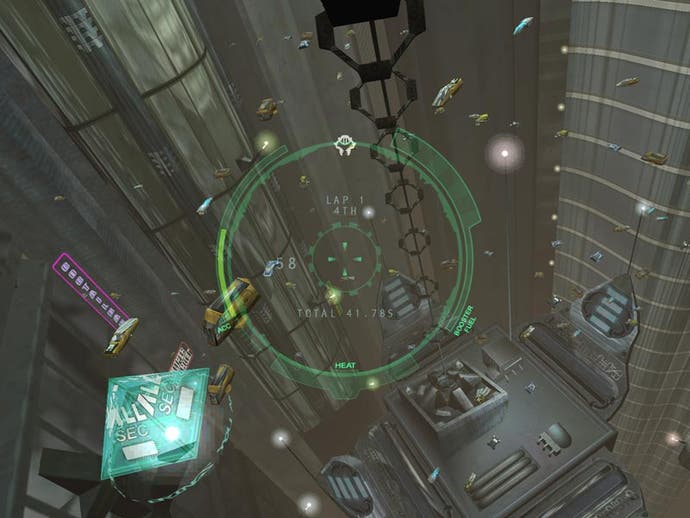Ballistics
Preview - a visual tour de force from Grin, and one of the GeForce 3's stunning openers

nfiniteFX Excitement
The year is 2090, and mankind is at a sort of technological zenith - everyone lives a pleasant life, never having to worry about holes in the economy and such, and the world is a stable place, free from disease and conflict. But with world peace comes world boredom. There's nothing to keep people happy, and that is where the evolution of "Ballistics" comes in. As a Ballistics Pilot, you throw yourself headstrong into the most awesome speed sensation ever dreamt up: a sport with no upper speed limit. Ballistics evolved from Formula One, with pilots trained from their teens using electronic reflex enhancers. When matured, these pilots are dumped in streamlined tunnels packed with obstacles, and a vehicle capable of going as fast as humanly possible. The goal? Victory. The game uses settings as diverse as the Belize jungle, Grand Canyon and the city centre of future Houston (which resembles something out of The Fifth Element). The vehicles, called "Speeders", are high tech hover bikes with a magnetic repel unit to keep them floating in the air when inside the track. A magnetic field is generated close to the walls, and the pilots can attach their Speeder to it to ensure stability of movement. Otherwise they're on their own in the dangerous centre of the tunnel. Budding pilots have plenty of pros and cons to consider. The cons are high-speed impacts with obstacles, and the pros are the cold hard cash. Each race pays as good as you deserve, and travelling at close to 3000 km/h (the office record at Grin), you're going to generate a lot of revenue. Speed and style are rewarded with cash bonuses, and of course Speeders can be upgraded in between events.

Exceeding GeForces
The upgrades include chassis updates, new engines and coolers. This is one of Ballistics' biggest trump cards - the trade off between speed and thermal dynamics. You have to keep your Speeder cool or else it will simply blow up. As such, the addition of coolers is mandatory. That said, coolers are large and bulky, and screw up your aerodynamics. Pilots have to make damn sure they can keep the trade off in check, because either way, their push to win will be affected. This introduces an element of strategy missing from futuristic racing games like Wipeout, and should help keep gamers plugging away at it. Imagine the sorts of techniques one must employ to travel at 3000 km/h… Players of Ballistics can control their Speeder by two systems. The first is where the Speeder hovers just centimetres above the tunnel's inner wall magnetic field, and can strafe 360 degrees around the tunnel keeping its direction. This is great for overtaking opponents and is a very precise control method. The second system can be switched to by hitting the detach button on the dashboard, and releases the Speeder from the magnetic field. Once in free motion, loops, rolls, turns -the whole kaboodle- are possible, but watch out for those damned obstacles! The downside of free movement, of course, is that it is not only harder to control, but can cause fatal collisions with the scenery. The attraction to Ballistics is of course its limitless speed potential, and we see it selling in droves based on that. But we also foresee the game doing well based on its ties with nVidia and its use of the explosive new features on the GeForce 3 graphics card.

Faballistic
Visually, Ballistics is astonishing. The screenshots dotted around these pages do it only scant justice - to see it in action is to truly understand how the next generation of racing games will look. Everything is sumptuously detailed, despite the fact that you are flying past it at hypersonic speeds. The engine, called the "Diesel Engine", renders from 20,000 to 110,000 polygons in the view port. There are over 1500 textures in total across the seven tracks and, as we saw at The Gathering a fortnight ago, fully animated environments and light effects. As developer Bo Anderson demonstrated to us, the world is alive around you, and although it isn't interactive for the most part, extraordinary detail has been extended to cover it. Effects like masked chrome, real time lighting and reflections, not to mention pixel and vertex shading, the two key additions to nVidia's GeForce 3 processor. The game also uses fully 3D sound to give the player the experience of travelling through the sound barrier. The Speeders themselves are amazingly detailed and resemble super bikes more than anything, with a deliciously detailed rider perched on the back. Every nook, cranny, bump and curve is accurately portrayed, and although not fully optimised, the code we saw at "The Gathering" performed extremely well on the AMD and nVidia hardware.
We said a while back that the GeForce 3 eliminated the era of the speed freak, and brought along a world of visual quality and precision. With Ballistics, it looks like everyone's prayers will be answered.
-


.png?width=291&height=164&fit=crop&quality=80&format=jpg&auto=webp)




.jpg?width=291&height=164&fit=crop&quality=80&format=jpg&auto=webp)
